by atmara | May 8, 2017 | Art, Mandala History, Mandala Monday, Mandalas, Meditation, yoga
The Mandala – Origin and use
The way in which Mandalas are made is already ancient. In the prehistory, the first simple representations were made, which can be compared with the mandala. These include, for example, rock drawings, which according to estimates by archaeologists could be 25,000 to 30,000 years old. These represented circles with a center, which are interpreted by the scientists as sun cycles.
Also in the Celts culture, the Indians, the Aborigines Australia and the South-American Inkas round sample forms with a center were found. In the emergence of different cultures and religions in Asia, the representations of the mandalas were artistically refined and provided with a great variety of colors. The impressive cult designs were filled with religious content and used in various religious rites in the East Asian countries and in India.
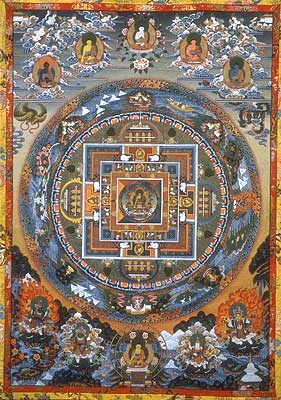
Tibetan Mandala
The versatile use of mandalas
For religions such as Buddhism and Hinduism, which are oriented towards the production of inner and outer harmony as the basis of knowledge and salvation, the mandalas became important objects for meditation. The forms are also found in Christian sacred temples. Medieval church windows and church paintings are often provided with similar representations.
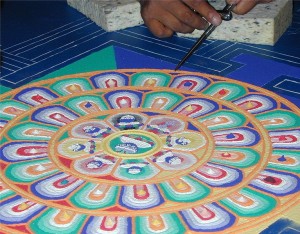
Tibetan monks making a temporary “Sand-Mandala”
in the City-Hall of Kitzbuehel in Austria.
Symbolic representations as a triangle with rays, the Holy Spirit as an illuminated circle, and similar symbols also use the representation principles of the mandala. The centered images greatly enhance the concentration in a meditation.
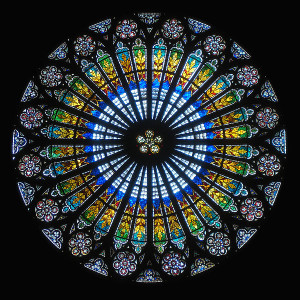
Interior of the rose at Strasbourg Cathedral.
Mandalas in Psychology?
C. G. Jung, a famous psychologist, used the principle of mandalas for examinations and treatments. He noted that a mandala can show the sense of purpose and direction. The Mandalas could convey a sense of structure, security, hope and wholeness in an intense concentration on the picture. In patients, he even found that in certain situations they spontaneously painted mandala forms when asked to paint without prescriptions.
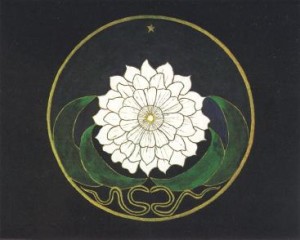
Mandala made by a Jung’s unknown patient before 1929
To date, there are numerous psychologists who use the mandala in their practice. This is based on the realization that the symbolism of a mandala always directly addresses the subconscious. The importance of mandalas, especially the circular shapes and shapes of squares, as an important element in meditation. In deepening into the pictorial representation, in which everything leads to the center, it is particularly well to sink into deep meditation. Especially in Tibet and India, the Mandalas served as meditation symbols and ritual actions.
Mandalas as a help in meditating
In practice, people can use different mandalas in meditation. Regardless of the complicated magical and ritual meanings that the individual mandalas have in different directions of Buddhism and Hinduism, their form is an excellent support. It is helpful to deal with the most important forms and colors at least.
This can accompany the attainment of a deep meditative state of content and lead to the desired emotions. As already mentioned in connection with mandalas in psychology, the subconscious is particularly addressed by each mandala. The view of the mandala, the deepening of its forms and colors, ensures a better concentration. Especially, the view should be directed towards the center.
Nothing around the mandala should distract from meditation. Depending on the condition of the person concerned in the meditation, the mandala can help to feel more peace, harmony, and serenity or to gain new strength, and to release one’s energies for vitality and creativity. However, a mandala never has a detachment from the person. It is always only a means, an important help with intensive meditation and the sinking into one’s own, deeper ego. The actual meditation, the concentration necessary for it always must the man himself. This can not be replaced by the effect of a mandala.
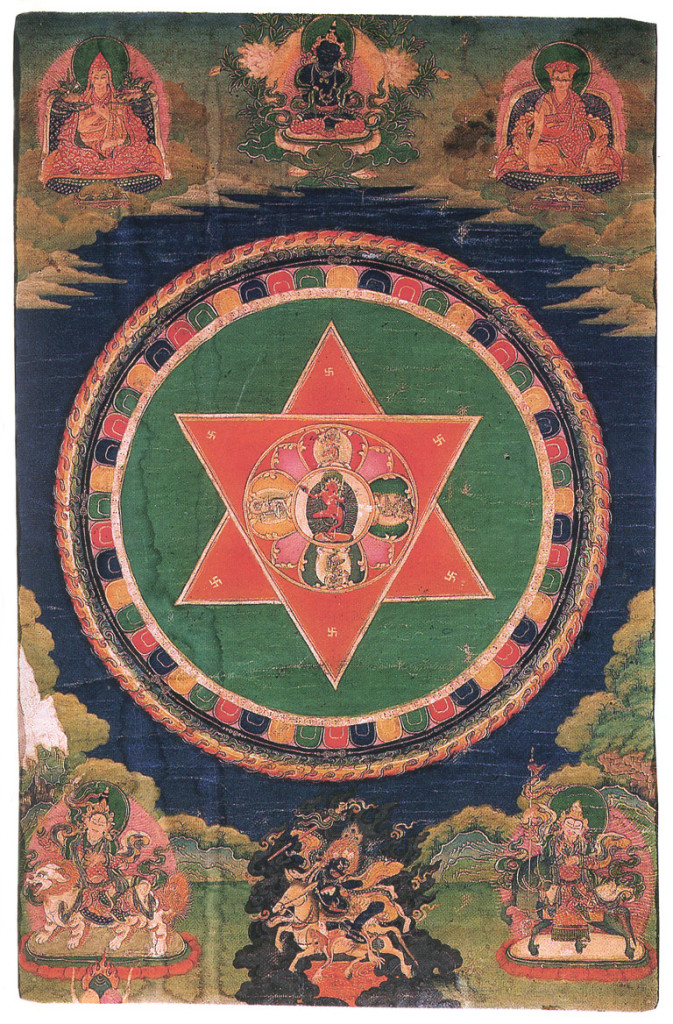 Vajravarahi Mandala
Vajravarahi Mandala
Mandalas, especially in Hinduism and Buddhism, have a ritual meaning as an element of meditation. However, the application goes far beyond the actual roots, so that the psychology and the meditation of the geometric mandala forms positively serve itself. And no, Mandalas do not have to be round. Most of them are actually.
For other offerings of The Yoga Mandala see:
Mandala Beach Blankets
Mandala Tapestry
The Yoga Mandala
——————————————————————————————————–
I look forward to your thoughts and comments!
Like this:
Like Loading...
by atmara | Dec 5, 2011 | Art, Creativity, Mandala Monday, Mandalas
Author: Marissa Moonwhisper
“Mandala” is a Sanskrit term meaning “sacred circle.” The balance, harmony and cohesion of a circular symbol is consistent with many forms of Eastern beliefs about universal energy (Chi) or the dynamic flow of Yin and Yang in holding opposite forces together for a complete whole. In many Tibetan monasteries, sand mandalas are used to prepare a space for sacred rituals as a form of centering and focus.
Modern Art Therapy uses mandala drawing as a means of helping a person more deeply understand the emotions, thoughts and sensations of their life or particularly challenging experiences in the past or present. It is within this healing and understanding function of raising self-awareness that mandala astrology is a developing art.
Reading Mandalas As Life Cycle Awareness
The circular form of a mandala represents the cycles or seasons of a person’s life, from birth through youth, maturity and onto death. They are representative, and can show the “life cycle” of a certain relationship, career or experience, indicating time for a change. When facing the upright drawing, the cycle begins at the bottom, just to the left of lowest point of the circle, and continues clockwise around the cycle.
The other major division of the mandala comes from separating the top half of the circle and the bottom half of the circle. As another level of reading, looking at the elements in the upper half bring understanding about external traits, feelings and thoughts. Meanwhile, the lower half describes the usually unexpressed, inner feelings and thoughts a person is experiencing.
Components of A Mandala
Interpreting a mandala that is spontaneously drawn by a person hoping to explore their inner world focuses on several key components, reflecting other aspects of astrological interpretation.
Color–the primary aspect of a mandala,is usually reflective of deep internal as well as external emotions. Individual colors as well as the overlapping use of colors can speak to a conflicted, unbalanced circumstance or a growing harmony among a person’s different aspects of life.
Numerology–though different in mandalas than in its own art, mandalas use the common universal interpretations of numbers (zero as wholeness, two as balance, etc.). By counting and assessing the numbers of a certain shape (loop, square) or the quantity of colors used in the drawing, a mandala reader can address the intensity or importance of each symbol.
Shapes or objects–identifying what feelings or thoughts a person associates with shapes that appear in the mandala in certain season, or if a certain figure has preeminent position in one area of the mandala, these offer insight into the value or challenge of that season.
Placement–with the life cycle positioning of a mandala, where each of the above elements fall within the circle help indicate their function in that period of a person’s life.
Mandala astrology is an art that needs more students to develop and cultivate its rich aspects for individual self-awareness and personal healing journeys. The few who already utilize mandalas have found a great comfort and harmony that can be achieved by drawing and interpreting the sacred circles.
Article Source: http://www.articlesbase.com/art-and-entertainment-articles/interpreting-mandalas-within-astrology-1846633.html
About the Author
If you want a great psychic reading online visit www.MoonWhisper.com Or www.True Psychics.com for amazingly accurate psychics that will provide psychic readings for your regarding love romance finance career and more. Also try free daily horoscopes and free psychic oracles as well as joining our free psychic community online. Marissa “MoonWhisper” Valentin is owner , webmaster and a psychic adviser with over 20 years of experience .

——————————————————————————————————–
I look forward to your thoughts and comments!
Be sure to Subscribe to this blog either by RSS or Email via the forms on the top right column of the page.
Like this:
Like Loading...
by atmara | Oct 31, 2011 | Art, Mandala Monday, Mandalas, Meditation
Meditation has been used since ancient times to reduce stress, find one’s center, calm the mind and soothe the soul. Contrary to what you may think, not all meditation is spiritual, just as many individuals use it for personal use. Regardless of your reasoning or goals you hope to achieve, your personal journey can be significantly enhanced by using a mandala.
Sanskrit, for the English word circle, the mandala has been introduced to the population through Buddhist and Hindu religions. When you choose a mandala for meditation purposes, it is important to be aware that each one is very different. They offer their individual symbolism and quite often, a deity is housed in the center.
When you gaze at a mandala during meditation and follow one point to another your mind and body naturally become intertwined. When you are able to become one with the mandala, you have entered into a quasi state as you are captivated by the mandala’s design.

Choosing the right mandala is imperative for your journey. Although Tibetan Monks sweep their sand mandalas up and take them to a nearby body of water so they can finalize their circle of life, your actions don’t need to be as extreme to be effective. In fact, there are coloring pages which are available online that can be downloaded or you can simply draw your own if you’re feeling creative.
(See the post, 10 Links to Free Mandala Coloring Pages for sources of coloring images)
If you want a more traditional mandala, you will find them primarily made from silk, thangka or sand but contemporary versions are available in the form of photographs, paintings, fiber arts and even sculptures.

When you prepare to meditate, it is important that you are able to find yourself in a comfortable position, somewhere quiet where you won’t be interrupted with your mandala placed across from you at eye level. Some find it helpful to create an altar for their mandala, adding objects that are symbolic of peace, grace, purity and spirituality.
When you begin to meditate, you will start at the entry point which is always the mandala’s outer ring. According to Tibetan tradition, it is this part of the mandala that essentially purifies you so that you are able to continue on with your journey. As you concentrate on the various colors, shapes and lines, the path gradually leads you toward the center. Quite often, you will reach a dead end on your journey, this is to be expected. A mandala takes you on a path to enlightenment so there are times you need to reverse your path to get closer to the center.
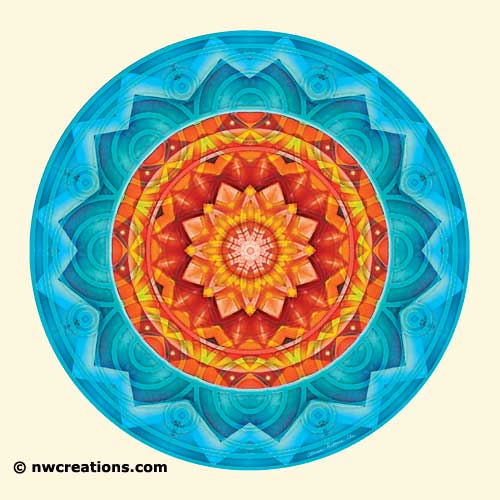
Mandalas of Deep Trust, No. 8
© Atmara Rebecca Cloe
As you make your journey inhale and exhale slowly through the nose, concentrating on your body’s rhythm. You will find that as you become one with the wisdom of the universe, your body’s rhythm will begin to match the design of the mandala.
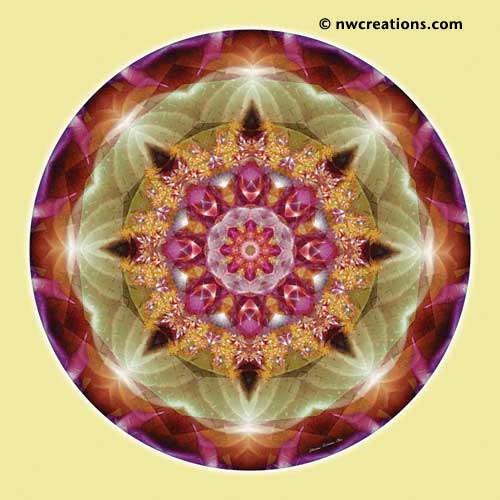
Mandalas from the Heart of Peace, No. 1
© Atmara Rebecca Cloe
It is recommended to partake on this journey to enlightenment for anywhere between 15 to 30 minutes. You will likely feel energized as well as quite surprised at just how powerful this sacred object actually is. As you release the stresses of the outside world, you will become quiet, calm, still and tranquil.
Article by Epouna
www.meaningofmandalas.com
Images from Wikimedia Commons and Atmara Rebecca Cloe
See all of Atmara’s Mandalas at Zazzle.com
——————————————————————————————————–
I look forward to your thoughts and comments!
Be sure to Subscribe to this blog either by RSS or Email via the forms on the top right column of the page.
Like this:
Like Loading...




 Vajravarahi Mandala
Vajravarahi Mandala


